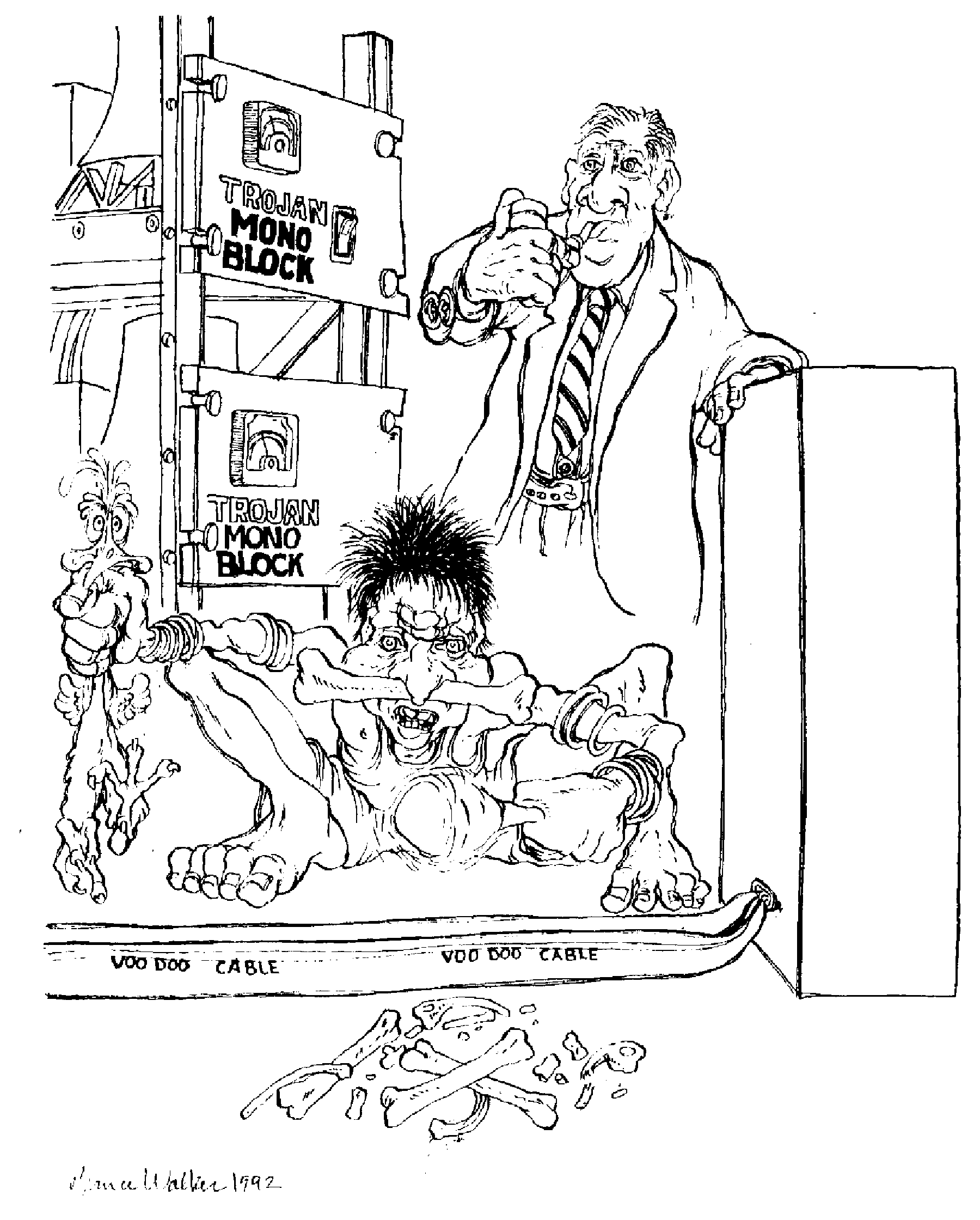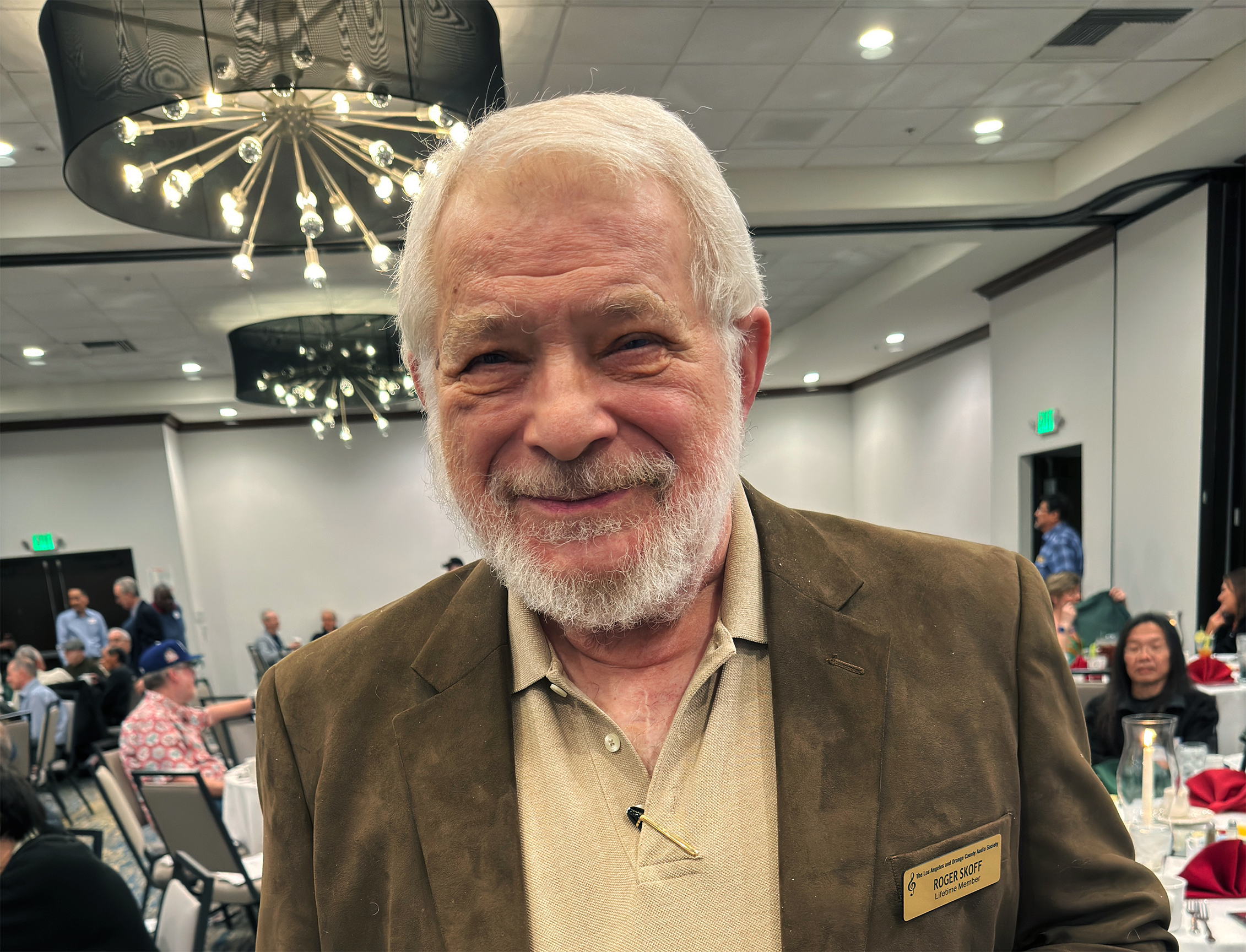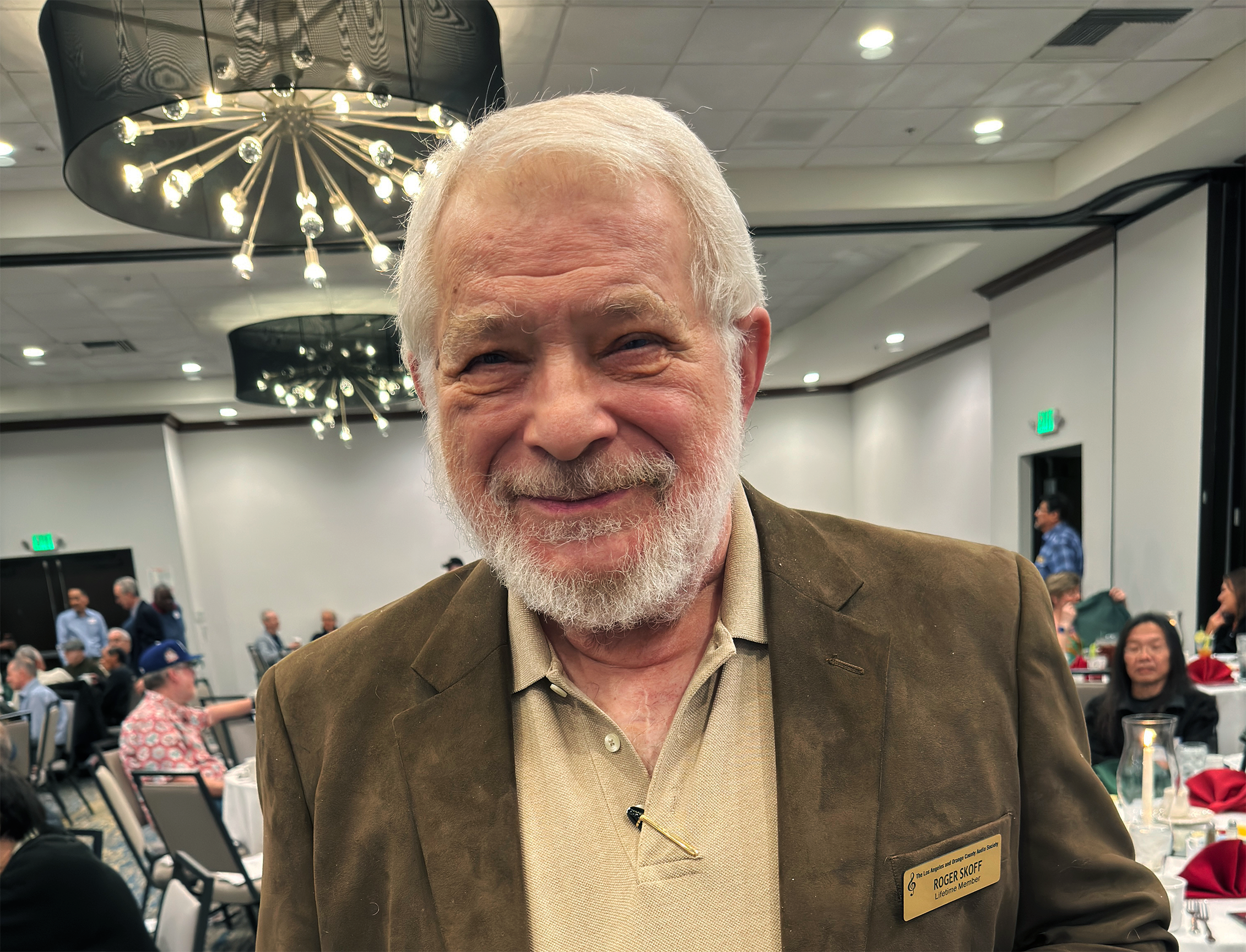Roger Skoff of RSX Technologies at the LAOC Audio Society Gala, December of 2023 (photograph and image processing by David W. Robinson)
Roger Skoff writes more about the weirdest thing about our hobby.
In Part 1 of this article, I wrote how some people who claim to be audiophiles seem to be constantly on the attack against our hobby, claiming, for as long as I can remember, that one part of our hobby or another is/was all BS. Cables are one prime example, still regularly subject to doubters who not only claim that anything other than "hardware store" wire or Belden (or its ilk) is not only "snake oil" and "voodoo," but a willful attempt to defraud its buyer. These accusations have been applied to any number of things, including not only cables but cable lifters, various kinds of "magic" dots, discs, bowls, and treatments, and, although I can't recall any specific claims of fraud being involved, other claims that things just don't work or don't make any difference have been applied against amplifiers, power conditioners, and various other audio products of many kinds.
Complicating the problem has been the fact that some of the things called to question really don't work or make any difference, or, as with a number of things tried over the years, they seem to make an improvement twice—once, when you put them into your system, and once, again, when you take them out.
Further complicating the issue is the fact that just because you don't hear a difference on your system, in your room, playing (or even measuring with) your choice of source material, doesn't necessarily mean that there's no difference.
Any number of other things are possible, including the very real possibility that the sound that would reveal a difference to you is simply not there in the material that you're listening to or testing. (That's why you need to listen to a broad range of source material)
Even if that sound is there, there are still many reasons why you might not hear a difference. Here are just a few of them"
Maybe your system or some part of it is not capable of revealing that particular sound to you. Maybe the acoustics or setup of your listening room is keeping the difference from being heard. Maybe the difference is there and clearly audible but, not knowing what to listen for, you're simply not hearing it[1]. Maybe it's there and you're hearing it but, because your attention is focused on some other sonic characteristic, (something in the treble, for example) when you're focused on the bass, you're just not noticing it. Maybe it's there and you can't hear it because some other part of the music is masking it. (Think of the sound of musicians turning the pages of their scores being lost under the sound of an orchestral tutti. It is there; it was recorded; your system is playing it; but you don't hear it because it's buried under all of the other sound.) Maybe it was there, and you could have heard it but, because the part of the music that revealed it was brief and you were thinking of something else at that moment, you simply missed it.
Or maybe it was there and—in a reversal of the "placebo effect"[2]b—because you didn't believe it was possible, you didn't mentally accept it or just dismissed it as an auditory hallucination.
That, I believe, is far more common than one might think. If you read the comments on some of the audiophile sites on the internet, you'll regularly find people claiming "BS," "snake oil," "voodoo," or even fraudulent or criminal intent about things they know nothing about, simply because their "common sense" or the conventional wisdom tells them that they—whatever those things may be—shouldn't be possible.[3]
It's even worse when the refusal to believe in or accept things comes about as a result of having a formal education. In 2015 I wrote an article for The Absolute Sound called "Electrical Engineering and The High End." In it, I pointed out that electrical engineering was invented by the telephone company for its own use, simply because, it had to. Until the telephone came along, no one had ever had the need to pass a complex signal (the basic voice spectrum) through a length of wire, and there was little or no prior knowledge to rely on. This fact that it was the telephone company that laid the foundation for electrical engineering has continued to affect high-end audio even to this day.
Once it was invented, the value of an electrical engineering program was obvious, and universities everywhere rushed to add it to their curriculum and to assist in developing it to where it is today. What they didn't do, though, was to say that it had started as telephone company electrical engineering. That was, and still remains important because, while to the telephone company, a wire a mile long may be considered "short," to a HiFi system, one of less than one one-hundredth of that length—just 50 feet—can be colossal and can have clearly audible and deleterious sonic effect.
And that's the problem, overall. Conventional engineering practice says that the factors significant to the performance of a wire are its resistance (R), its inductance (L), its capacitance (C), and its characteristic impedance (Z0). Having learned it in school, many engineers think that that must be the case for all wires, and, in talking about cables for HiFi, tend to think that it must apply to them, too. In fact, though, unless a cable is very long (by HiFi standards) or the frequencies to be passed by it are well above the audio spectrum, Z0 may be completely irrelevant and R,C, and L may tell only part of the story, with significant factors like capacitive discharge effects and burn-in being either unheard of or disregarded as voodoo or snake oil and any claims of their effects being audible held to be imagination or placebo effect.
This kind of thinking—that if it's not in the book it must not be either real or applicable[4]—is found not just about wires, but all through HiFi[5], with altogether too many audiophiles or even so-called "authorities" relying more on what they've been taught or what "makes sense" than on what their own ears or the experience of others has taught them.
For those who make blanket claims that things—at least in the electrical part of our hobby – don't or can't make a difference, I would remind them that It's impossible to do anything at all to an electrical signal without changing it. Even just sending DC through an uninsulated single wire will change the signal" Some of it will be lost as heat because of the resistance of the wire. The degree of loss may be tiny, but it will always be there. When the wire is insulated, and the signal is AC instead of DC (a music signal), there will not only be resistance losses but also either losses or added artifacts due to self-inductance. The signal's velocity of propagation (speed of the passed signal as a percentage of the speed of light) will also be changed to a degree determined by the characteristics of the insulation. When the insulated wire becomes a cable (two wires constituting the forward and return paths of a circuit in a single structure) all of the above happen plus mutual inductance and capacitive discharge effects—all of which are always there to alter the signal from its original state. People who think that it's impossible for a cable to affect the sound are simply wrong. The truth is that it's impossible for them not to. And that applies even more to things (electronics components) more complex than just simple cables.
The fact of is that—even when a designer or audiophile is trying to get something to do nothing (as HiFi purist claim to do when they say they want to hear their music but not their system)—it simply can't be done. And when it comes down to it, it's more likely that it's the naysayers and trolls, and not those who hear the differences, who are spreading the BS.
Use your ears; find out for yourself.
[1] Consider a plucked string bass (Bass Viol), for example. Did you know that there are actually three parts to the sound? First there's the actual pluck of the string, then the sound spreads to the whole string and, through its bridge, to the body of the instrument, then the whole body of the instrument resonates to the tone. Many people, not knowing that they're there, never hear the first two parts ("pluck" and "spread"), and hear only the "body" part of the sound—until somebody tells them that the other parts are there and they start to listen for them. At that point they become obvious!
[2] Where, because you do believe it, taking a pill with no medical benefits "cures" you anyway.
[3] Think of all the other things that, over time, have changed from "common-sense-impossible" to everyday reality. Like the earth being round or circling the sun (instead of the other way around) or the ideas that sound or even pictures could be recorded and/or transmitted through wires or the air.
[4] And the other side—that if it IS in the book, it must be true.
[5] In amplifiers, tube vs. solid state prejudices, vibration control systems, the debates over damping factor or digital vs. analog, and many other things.









































